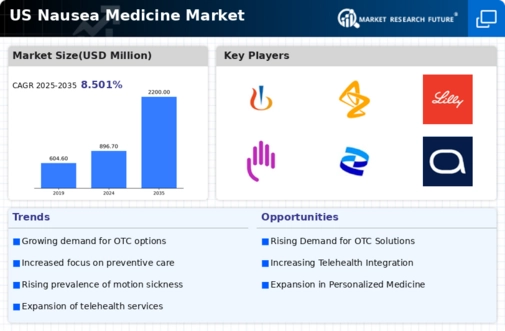Expansion of E-commerce Platforms
The rapid expansion of e-commerce platforms is reshaping the distribution landscape of the nausea medicine market. With the convenience of online shopping, consumers are increasingly turning to digital channels to purchase medications. In 2025, online sales of nausea medications are projected to reach $1 billion, representing a significant portion of the overall market. This shift not only provides consumers with greater access to a variety of products but also allows for competitive pricing and promotions. The nausea medicine market is likely to benefit from this trend as manufacturers and retailers enhance their online presence. Furthermore, the integration of telehealth services with e-commerce platforms may facilitate easier access to nausea treatments, thereby driving market growth.
Growing Awareness of Mental Health
The rising awareness of mental health issues, including anxiety and stress, is contributing to the growth of the nausea medicine market. Many individuals experience nausea as a symptom of anxiety disorders, leading to an increased demand for effective treatments. In 2025, it is estimated that around 20% of the adult population in the US will experience some form of anxiety disorder, which correlates with a heightened need for nausea medications. The nausea medicine market is responding to this trend by developing products that address both nausea and its psychological triggers. This dual approach not only broadens the market's appeal but also encourages healthcare providers to consider comprehensive treatment plans that encompass both physical and mental health.
Rising Incidence of Nausea Disorders
The increasing prevalence of nausea-related disorders, such as motion sickness, morning sickness, and chemotherapy-induced nausea, is a primary driver for the nausea medicine market. According to recent data, approximately 30% of adults experience motion sickness at some point in their lives, while around 50% of pregnant women report nausea during their first trimester. This growing incidence necessitates effective treatment options, thereby propelling the demand for nausea medications. The nausea medicine market is likely to see a surge in product development aimed at addressing these specific conditions, as healthcare providers seek to offer tailored solutions to patients. Furthermore, the rise in awareness regarding nausea disorders has led to increased consultations with healthcare professionals, further driving the market's growth.
Increased Focus on Preventive Healthcare
The shift towards preventive healthcare is influencing the nausea medicine market significantly. As individuals become more health-conscious, there is a growing emphasis on managing symptoms before they escalate into more severe conditions. This trend is reflected in the rising sales of over-the-counter nausea medications, which accounted for approximately 40% of the total market share in 2025. The nausea medicine market is adapting to this change by introducing products that not only alleviate symptoms but also prevent their occurrence. Additionally, educational campaigns aimed at informing the public about the importance of early intervention in nausea management are likely to enhance market growth. This proactive approach to health management is expected to foster a more robust demand for innovative nausea treatments.
Regulatory Support for Innovative Treatments
Regulatory bodies in the US are increasingly supportive of innovative treatments for nausea, which is positively impacting the nausea medicine market. Recent initiatives aimed at expediting the approval process for new medications have led to a surge in research and development activities. In 2025, the market is expected to witness the introduction of several novel therapies that target specific nausea triggers, such as those associated with chemotherapy or surgery. The nausea medicine market is likely to benefit from this regulatory environment, as it encourages pharmaceutical companies to invest in the development of advanced treatment options. This influx of new products not only enhances competition but also provides patients with a wider array of choices, ultimately driving market growth.

















Leave a Comment